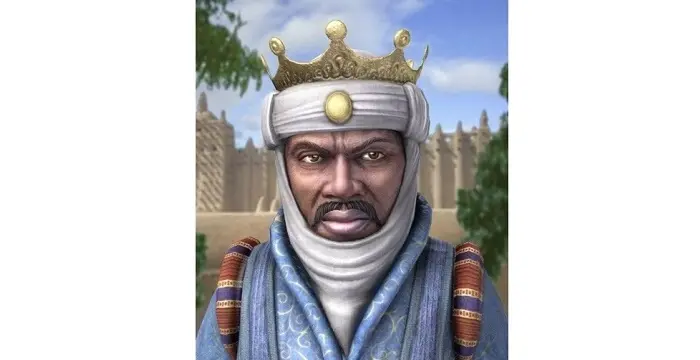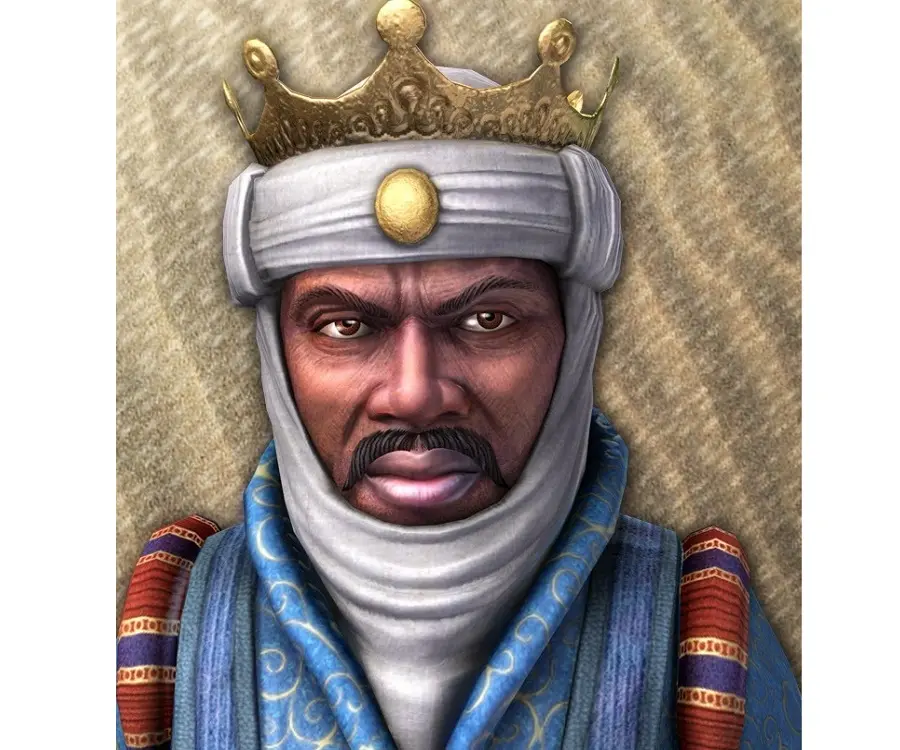
Mansa Musa - Kings, Timeline and Personal Life
Mansa Musa's Personal Details
Mansa Musa, also known as Musa Keita I of Mali, was the tenth Sultan of the Mali Empire
| Information | Detail |
|---|---|
| Birthday | 1280 |
| Died on | January 1, 1337 |
| Nationality | French |
| Famous | Historical Personalities, Emperors & Kings, Emperors, Kings |
| Spouses | Inari Kunate |
| Siblings | Suleyman |
| Known as | Musa I of Mali, Musa Keita I of Mali, Musa Keita I |
| Childrens | Maghan I |
| Birth Place | Mali |
| Gender | Male |
| Father | Faga Laye |
| Born in | Mali |
| Famous as | Emperor |
| Died at Age | 57 |
// Famous Kings
Sundiata Keita
Sundiata Keita was the founder of the Mali Empire in West Africa. This biography profiles his childhood, early life, struggles, founding of empire, rule, administration, achievements and also gives some fun facts.
Ashoka
Ashoka was the third emperor of the Mauryan Dynasty and ruled almost the entire Indian subcontinent. This biography profiles his childhood, life, reign, achievements and timeline
Murad IV
Murad IV was one of the mighty Sultans in the history of the Ottoman Empire. This biography profiles his childhood, family, accession, rule, administration and timeline.
Mansa Musa's photo
Who is Mansa Musa?
Mansa Musa, also known as Musa Keita I of Mali, was the tenth Sultan of the Mali Empire. He is believed to be one of the richest individuals to have walked on this planet. He belonged to the Keita Dynasty and came to power after Abu-Bakra-Keita II left on an expedition to explore the Atlantic Ocean, leaving Musa as his deputy and never returned. Musa ruled in an era when Europe was reeling under an economic crisis and his kingdom flourished due to rich deposits of gold and salt in abundance. Mansa Musa became very famous in Europe and West Africa after he made the hajj pilgrimage to Mecca, which was a difficult proposition in those days. His cavalcade consisted of about 60,000 soldiers, slaves and followers who escorted him through the kingdoms en-route where he spent lavishly and distributed alms to the poor that upset the economy of the region. He became famous by annexing neighbouring states and bringing in reforms in line of Islamic practises in his kingdom. He also built many mosques and established madrasas, some of which are still standing today. He took special interest in Timbuktu and converted it into a centre for trade and learning in West Africa. Unfortunately, his successors failed to carry on his legacy for long and fell to invaders from Morocco and the kingdom of Songhai.
// Famous Emperors
Sundiata Keita
Sundiata Keita was the founder of the Mali Empire in West Africa. This biography profiles his childhood, early life, struggles, founding of empire, rule, administration, achievements and also gives some fun facts.
Ashoka
Ashoka was the third emperor of the Mauryan Dynasty and ruled almost the entire Indian subcontinent. This biography profiles his childhood, life, reign, achievements and timeline
Murad IV
Murad IV was one of the mighty Sultans in the history of the Ottoman Empire. This biography profiles his childhood, family, accession, rule, administration and timeline.
Childhood & Early Life
Mansa Musa was born into the Keita Dynasty in 1280s in Mali as Musa Keita. His grandfather, Abu-Bakra-Keita, was the brother of Sundiata Keita, the founder of the Malian Empire. His father, Faga Laye, did not play any role in the kingdom. However, Mansa Musa ascended the throne in 1312 through the practice of appointing a deputy when a king goes on a pilgrimage or important mission and is away for a long period.
He was appointed deputy to Abu-Bakra-Keita II who reportedly embarked on an expedition to explore the Atlantic Ocean and never returned. Thus, the throne passed on to Musa Keita who picked up the title of Mansa, meaning King, becoming the 10th Sultan of the wealthy West African kingdom.
Accession, Expansion of Empire & Rule
When Musa came to power, Europe was reeling under an economic crisis due to civil wars. However, the West African state was flourishing with riches due to large deposits of gold, precious stones and salt. His kingdom originally consisted of what is today Ghana, Mauritania and Mali.
He expanded his empire by annexing the city of Timbuktu and re-establishing control over Gao. He is believed to have conquered 24 cities and their neighbouring villages during his reign to stretch his kingdom over 2000 miles covering parts of Nigeria, Ethiopia, Chad and Gambia in addition to the original boundaries of his kingdom. As he gained power, he adopted many titles such as ‘Emir of Melle’, ‘Lord of the Mines of Wangara’ and ‘Conqueror of Ghanata’.
He established diplomatic ties with North Africa that facilitated unprecedented Trans-Sahara trade which further enriched his kingdom and ushered in prosperity among his people. His main sources of income were from gold and salt that were found in abundance in his empire.
He embarked upon a mission to build mosques and madrasas in his kingdom and the places he brought under his influence. Some of the architectural wonders that came up during his time are the ‘Sankore Madrasah’ in Timbuktu and the ‘Hall of Audience’ in his capital, Niani.
Timbuktu soon became a centre for trade and learning in the Sub-Sahara African region. Its markets flourished and it propagated Islamic religion and culture to its neighbours. The University of Sankore in Timbuktu became famous, drawing scholars from Africa and the Middle-East.
Though his kingdom was invaded after his death, his rich legacy lived on for generations to come and to this day there are mausoleums, libraries and mosques that stand as testimony to his golden era of rule.
Mecca Pilgrimage
Musa was a pious Muslim and undertook a pilgrimage to Mecca during 1324-1325. What set him apart from his contemporaries is the opulence with which he went about his journey. It is said that he moved with a large cavalcade of men and animals including 12,000 slaves who were laden with gold and riches that were given out as alms in the Arab cities he passed through on his way to the holy city. He also built a new mosque in every city that he halted on a Friday.
His journey was documented by eyewitnesses and his reputation spread far and wide to soon reach Europe, putting Mali on the world map as a rich and prosperous kingdom. He amassed so much wealth and power that he came to be known as one of the most powerful and influential rulers of all time.
Musa was ordained with the coveted title of ‘Al-Hajji’ on completion of his pilgrimage to Mecca and gained knowledge about orthodox Islam from his experience. He returned to Mali with North African scholars and architects to reform Islam and bring about development in his country.
Mansa Musa’s pilgrimage to the holy city of Mecca was a major landmark in his life. The experience inspired him to reform Islam in his kingdom and build famous mosques like the legendary Djinguereber Mosque that stands till today.
Personal Life & Legacy
Mansa Musa is said to be one of the richest individuals to have ever lived on this earth. His riches in terms of today’s economic value would amount to about $ 400 billion. He was married to Inari Kunate and had two sons.
The exact date of death of Mansa Musa is not recorded. However, as per calculations made by historians, he died around the year 1337, after reigning for 25 years. He was succeeded by his elder son, Mansa Maghan, who carried on his legacy. However, his successors failed to maintain his empire, which remained in a state of decadence due to civil wars and invading armies of Morocco and the kingdom of Songhai.
Trivia
He took special interest in Timbuktu where he built schools, mosques and a university. The legendary Djinguereber Mosque, which is part of the University of Timbuktu, built by him still stands today.
It is said that a descendant of the prophet Muhammad went to Timbuktu to teach Malian Muslims, but failed the entrance test to the Madrasa and had to study for three years before becoming a student in the Madrasa.
Upon his visit to Cairo, he spent so much gold and made donations to the poor that it took years for the city to recover from the risen inflation.
// Famous Emperors & Kings
Sundiata Keita
Sundiata Keita was the founder of the Mali Empire in West Africa. This biography profiles his childhood, early life, struggles, founding of empire, rule, administration, achievements and also gives some fun facts.
Ashoka
Ashoka was the third emperor of the Mauryan Dynasty and ruled almost the entire Indian subcontinent. This biography profiles his childhood, life, reign, achievements and timeline
Murad IV
Murad IV was one of the mighty Sultans in the history of the Ottoman Empire. This biography profiles his childhood, family, accession, rule, administration and timeline.
Mansa Musa biography timelines
- // 1312Mansa Musa was born into the Keita Dynasty in 1280s in Mali as Musa Keita. His grandfather, Abu-Bakra-Keita, was the brother of Sundiata Keita, the founder of the Malian Empire. His father, Faga Laye, did not play any role in the kingdom. However, Mansa Musa ascended the throne in 1312 through the practice of appointing a deputy when a king goes on a pilgrimage or important mission and is away for a long period.
- // 1324 To 1325Musa was a pious Muslim and undertook a pilgrimage to Mecca during 1324-1325. What set him apart from his contemporaries is the opulence with which he went about his journey. It is said that he moved with a large cavalcade of men and animals including 12,000 slaves who were laden with gold and riches that were given out as alms in the Arab cities he passed through on his way to the holy city. He also built a new mosque in every city that he halted on a Friday.
- // 1337The exact date of death of Mansa Musa is not recorded. However, as per calculations made by historians, he died around the year 1337, after reigning for 25 years. He was succeeded by his elder son, Mansa Maghan, who carried on his legacy. However, his successors failed to maintain his empire, which remained in a state of decadence due to civil wars and invading armies of Morocco and the kingdom of Songhai.
// Famous Historical Personalities
Sundiata Keita
Sundiata Keita was the founder of the Mali Empire in West Africa. This biography profiles his childhood, early life, struggles, founding of empire, rule, administration, achievements and also gives some fun facts.
Ashoka
Ashoka was the third emperor of the Mauryan Dynasty and ruled almost the entire Indian subcontinent. This biography profiles his childhood, life, reign, achievements and timeline
Jetsun Pema
Jetsun Pema is the Queen consort of Bhutan. Check out this biography to know about her childhood, family life, achievements and fun facts about her life.
Murad IV
Murad IV was one of the mighty Sultans in the history of the Ottoman Empire. This biography profiles his childhood, family, accession, rule, administration and timeline.
Xerxes I
Xerxes I (Xerxes the Great) was the fourth and the most famous king of the Archaemenid dynasty of Persia. This biography profiles his childhood, family, personal life, life history, achievements, campaigns, administration, death and other facts.
Sargon of Akkad
Sargon of Akkad, also called ‘Sargon the Great’, ‘Sarru-Kan’ and ‘Shar-Gani-Sharri’, was the founder and first king of the Akkadian Empire. This biography profiles his childhood, life, rule, administration, timeline, and gives some fun facts.
Mansa Musa's FAQ
When was Mansa Musa died?
Mansa Musa was died at 1337-01-01
Which age was Mansa Musa died?
Mansa Musa was died at age 57
Where is Mansa Musa's birth place?
Mansa Musa was born in Mali
What is Mansa Musa nationalities?
Mansa Musa's nationalities is French
Who is Mansa Musa spouses?
Mansa Musa's spouses is Inari Kunate
Who is Mansa Musa siblings?
Mansa Musa's siblings is Suleyman
Who is Mansa Musa childrens?
Mansa Musa's childrens is Maghan I
Who is Mansa Musa's father?
Mansa Musa's father is Faga Laye
How famous is Mansa Musa?
Mansa Musa is famouse as Emperor






